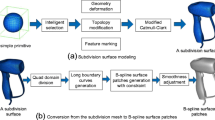Abstract
A novel interim core scheme (ICS) is presented in this paper to construct a furcating object with multibranches. These M branches with arbitrary N-sided boundaries can be positioned freely but cannot be overlapped with each other. A furcating object can be built by blending these branches. The essence of the scheme is to construct a joint mesh that blends the initial control meshes of the M branches, and the smoothness of the resulting surfaces will only depend on the joint mesh and subdivision scheme applied. Some illustrative objects are given to verify the feasibility of ICS.
Similar content being viewed by others
References
Hoffmann CM, Rossignac JR (1996) A road map to solid modeling. IEEE Trans Visual Comput Graph 2(1):3–10
McMahon C, Browne J (1998) CAD/CAM, Principles, Practice and Manufacturing Management, 2nd edn. Addison-Wesley Longman Publishing Co., Inc. Boston, MA, USA
Piegl L, Tiller W (1997) The NURBS book, 2nd edn. Springer, Berlin Heidelberg New York
Piegl L, Tiller W (1999) Cross-sectional design with boundary constraints. Eng Comput 15(2):171–180
Piegl L, Tiller W (1999) Filling n-sided regions with NURBS patches. Vis Comput 15(2):77-89
Ye X, Cai Y-Y, Chui C, Anderson JH (2002) Constructive modeling of \(G^1\) bifurcating. Comput Aided Geom Des 19:513–531
Bloomenthal J (1995) Skeletal design of natural forms. Dissertation, University of Calgary
Bloomenthal J, Shoemake K (1991) Convolution surfaces. Proceedings of SIGGRAPH 91, pp 251–256
Oeltze S, Preim B (2004) Visualization of anatomic tree structures with convolution surfaces. IEEE/Eurographics Symposium on Visualization, pp 311–320
Pasko A, Adzhiev V, Sourin A, Savchenko V (1995) Function representation in geometric modeling: concepts, implementation and applications. Vis Comput 11(8):429–446
Pasko A, Adzhiev V (2002) Function-based shape modeling: mathematical framework and specialized language. 4th International Workshop ADG 2002, pp 132–160
Pasko G, Pasko A, Ikeda M, Kunii T (2002) Bounded blending operations. In: Proceedings of the International Conference on Shape Modeling and Applications (SMI 2002). IEEE Computer Society, pp 95–103
Wywill B, Galin E, Guy A (1999) Extending the CSG tree: warping, blending and Boolean operations in an implicit surface modeling system. Comput Graph Forum 18(2):149–158
Galbraith C, Prusinkiewicz P, Wyvill B (2002) Modeling a Murex cabritii sea shell with a structured implicit surface modeler. Visual Comput 18(2):70-80
Galbraith C, Mündermann L, Wyvill B (2004) Implicit visualization and inverse modeling of growing trees. Comput Graph Forum 23(3):351-360
Doo D, Sabin M (1978) Analysis of the behavior of recursive division surfaces near extraordinary points. Comput Aided Des 10(6):356–360
Catmull E, Clark, J (1978) Recursively generated B-spline surface on arbitrary topological meshes. Comput Aided Des10(6):350–355
Loop C (1987) Smooth spline surfaces based on triangles. Dissertation, University of Utah, Department of Mathematics
Schweitzer JE (1996) Analysis and application of subdivision surfaces. Dissertation, Department of Computer Science and Engineering, University of Washington
Reif U (1995) A unified approach to subdivision algorithms near extraordinary vertices computer aided geometric design 12:153–174
Reif U (1996) A degree estimate for polynomial subdivision surfaces of higher regularity. Proc Am Math Soc 124:2167–2174
Zorin D (1997) Subdivision and multiresolution surface representations. Dissertation, Caltech, Pasadena
Khodakovsky A, Schroder P, Sweldens W (2000) Progressive geometry compression. Proceedings of SIGGRAPH 2000, pp 271–278
Stam J (1998) Exact evaluation of Catmull-Clark subdivision surfaces at arbitrary parameter values. Proceedings of SIGGRAPH 1998, pp 395–404
Kobbelt L, Daubert K, Seidel HP (1998) Ray tracing of subdivision surfaces. 9th Eurographics Workshop on Rendering Proceedings, pp 69–80
Chen J (1997) Algorithmic graph embeddings. Theor Comput Sci 181:47–266
Akleman E, Chen J, Srinivasan V (2000) A new paradigm for changing topology during subdivision modeling. Pacific Graphics 2000, pp 192–201
Akleman E, Chen J, Eryoldas F, Srinivasan V (2001) Handle and hole improvement with a new corner cutting scheme with tension. Shape Modeling 2001, pp 183–192
Schroder P, Sweldens W (1995) Spherical wavelets: texture processing. Tech. Rep. 1995:4. Industrial Mathematics Initiative, Department of Mathematics, University of South Carolina
Piponi D, Borshukov G (2000) Seamless texture mapping of subdivision surfaces by model pelting and texture blending. Proceedings of SIGGRAPH 2000, pp 471–478
Levin A (1999) Interpolating nets of curves by smooth subdivision surfaces. Proceedings of SIGGRAPH 1999, pp 57–64
Levin A (1999) Combined subdivision schemes for the design of surfaces satisfying boundary conditions. Comput Aided Geom Des 16:345–354
Levin A (2000) Combined subdivision schemes. Dissertation, Tel-Aviv University, Israel, 2000
Tobler RF, Maierhofer S, Wilkie A (2002) A multiresolution mesh generation approach for procedural definition of complex geometry. In: Proceedings of the International Conference on Shape Modeling and Applications (SMI 2002), IEEE Computer Society, pp 35–42
MacMurchy P (2004) The use of subdivision surfaces in the modeling of plants. Dissertation, University of Calgary, Department of Computer Science
Felkel P, Kanitsar A, Fuhrmann A-L, Wegenkittl R (2004) Surface models of tube trees. Proceedings of Computer Graphics International 2004, pp 70–77
Jevans D, Wyvill B (1988) Ray tracing implicit surfaces. Research Report 88/292/04, University of Calgary, Department of Computer Science
Author information
Authors and Affiliations
Corresponding author
Rights and permissions
About this article
Cite this article
Ou, S., Bin, H. Subdivision method to create furcating object with multibranches. Visual Comput 21, 170–187 (2005). https://doi.org/10.1007/s00371-005-0280-8
Published:
Issue Date:
DOI: https://doi.org/10.1007/s00371-005-0280-8




